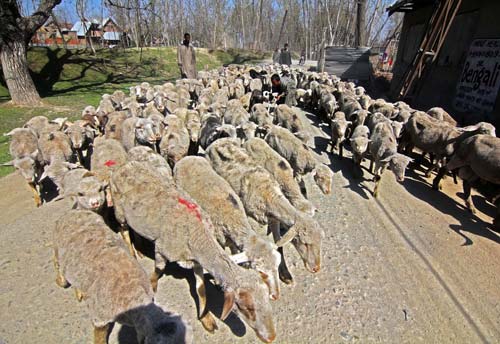There was a time when fresh milk used to arrive at the doorsteps of the inhabitants of Srinagar city early in the morning. Milk-sellers with their flock of ewes and does used to move from one street to another to cater to the needs of people. But as times changed, the men with flock have disappeared, Bilal Handoo reports.

At the crack of dawn, Habib, now in his early forties, used to come out of his house in Schirgari Mohalla in old Srinagar city with his flock of ewes and does. The paddling noise of the flock in the quiet morning streets along with the inviting screams of Habib brought out the inhabitants to purchase fresh milk from him. Habib is one of the members of the community that used to rear huge flock of sheep and goats in Srinagar city for a living. Scores of families were associated with this practice. But fifteen years down the line, Habib and his flock are history.
“Early in the morning, these men would go to their designated areas in the old city and sell milk to local households,” Mohammad Shaban, a fruit-seller in downtown locality recalls. “But they suddenly stopped their practice some fourteen or fifteen years ago.”
It takes a few steps from the old city’s Rajouri Kadal to reach the locality of Schirgari Mohalla. ‘Schirger’ in Kashmiri means ‘sellers of goat or sheep milk’. In this part of Srinagar, the localities have been named on the basis of occupations of their inhabitants. “Like in Sheeshgari Mohalla, the glass makers reside and in Teergari Pora, people who used to make arrows lived,” Abdul Khaliq, an elderly man, says.
There are a myriad number of accounts and reasons given by locals to describe why these milk-sellers abandoned their practice. What is certain is that the community no longer sells milk now. Open yards that were used to raise livestock have been taken over by concrete structures.
“The change was gradual,” says Habib, who now grows vegetables on his family land for a living. “Selling milk was very low paying job. The growing needs of day-to-day life compelled us to do something lucrative in life.”
Adjacent to Habib’s farmland is a graveyard. Fifteen years ago, Habib says it was an open field used as a grazing field for his flock. “It wasn’t occupied with so many tombs then. But as the situation took an ugly turn across the Valley, many dead bodies were subsequently buried here,” he says.
Among many tombs, one is elevated and looks different than others. This is the tomb of Mohammad Tahir Gani Ashai or Gani Kashmiri, a renowned Sufi poet of Kashmir whose verses influenced Dr Sir Muhammad Iqbal, Mir Taqi Mir, Ghalib and Sadat Hassan Mantoo. Kashmiri is adored in Iran for his classic style in Persian poetry. Iqbal refers to him as the nightingale of poetry in his works.
Kashmiri had once declined the invitation of Mughal emperor Aurangzeb who was impressed by his remarkable writings in Persian and wanted to know more about him and his versatile style of writing. Many say it was Gani’s belief that Mughals are oppressors and Kashmiris are oppressed that compelled him to decline Aurangzeb invitation.
With Habib and his class of people shifting to other occupations, the locals of old city recall their presence in the area with a tinge of nostalgia. “These people used to add different dimension to the place,” recalls Mohammad Ismail, a local goldsmith here. “They used to collect the milk of their goats or sheep in a very unique utensil and then pour the same into the buyers’ pot. The eagerness to see these men and their flock was especially high among children.”
For some inhabitants, the milk which arrived at their doorsteps early in the morning brought multiple health benefits, “Milk of sheep and goats has an advantage over cow’s milk,” says Mohammad Sultan. “It is easily digestible and has many other health benefits. People with ear ailments would consume it and get cured.”
Dr Sajad Amin, a valley based nutritionist who is practicing in Saudi Arabia says the humans can digest proteins in sheep and goat milk more easily than those in cow milk. “As a result, goat and sheep milk is an appropriate alternative for babies and toddlers who are allergic to cow’s milk and soy products,” Dr Amin says.
In fact, doctors say the milk of sheep and goats contains more calories than cow’s milk. “Both types of milk contain a range of vitamins,” Dr Amin says. “Besides, both these milks provide rich amount of calcium and phosphorus. They also offer trace amounts of zinc and iron as well as a lower level of sodium than cow’s milk.”
Habib and his tribe no longer sell milk. His flock is nowhere to be seen. But the locality bears the name of the trade they were associated with.















